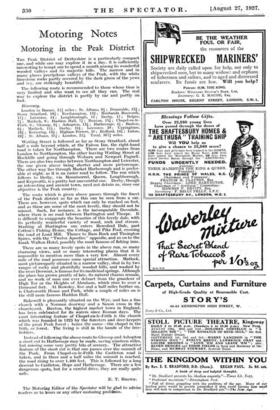Motoring Notes
Motoring in the Peak District
THE Peak District of Derbyshire is a particularly compact one, and while one may explore it in a day, it is sufficiently interesting to tempt one to spend a month among its wonderful wooded valleys and its majestic hills. The narrow and in many places precipitous valleys of the Peak, with the white Limestone rocks partly covered by the dark green of the yews and ivy, are strikingly beautiful.
The following route is recommended to those whose time is very limited and who want to see all they can. The real way to explore the district is partly by car and partly on foot.
_Itinerary.
London to Barnet, 111 miles ; St. Albans, 91 ; Dunstable, 121; Stony Stratford, 181; Northampton, 131; Husbands Bosworth, 171 ; Leicester, 14 ; Loughborough, 11 ; Derby, 17 ; Belper, 71 ; '
Matlock, 9 ; Haddon Hall, 71 ; Buxton, 131; Chapel-en-le- Frith, 6 ; Glossop, 81 Ashopton, 131 ; Hathersage, 41; Baslow, 61 ; Matlock, 111 ; Derby, 161; Leicester, 28 ; Uppingham, 191 ; Kettering, 141 ; Higham Ferrers, 10 ; Bedford, 141; Luton, 19} ; St. Albans, 104 ; London, 211. Total, 3671 miles.
Watling Street is followed as far as Stony Stratford, about half a mile beyond which, at the Falcon Inn, the right-hand road is taken for Northampton. There are two routes from London to Northampton, the other leaving Watling Street at Hockliffe and going through Woburn and Newport Pagnell. There are also two routes between Northampton and Leicester, the one given above being shorter and more picturesque. The other way lies through Market Harborough and is prefer- able at night, as it is an easier road to follow. The run which follows to Derby, via Mountsorrel, Quorn, Loughborough, and Kegworth, is a pretty but uneventful one. Derby, though an interesting and ancient town, need not detain us, since our objective is the Peak country.
The route which is given above passes through the finest of the Peak district so far as this can be seen from a car. There are, however, spots which can only be reached on foot, and as these are some of the most lovely, they should not be missed. Such, for instance, is the incomparable Dovedale, where there is no road between Hartington and Thorpe. It is difficult to exaggerate the beauties of this lovely dale, with its perfectly wonderful variety of wood, rock and stream. Starting at Hartington one enters Beresford Dale, past Cotton's Fishing House, the Cottage, and Pike Pool, crossing the road at Load Mill. Thence to Ilam Rock and Tissington Spires, with the "Twelve Apostles" opposite, and so on to the Izaak Walton Hotel, possibly the most famous of fishing inns.
There are so many lovely spots in the above run, so many charming views, and so many interesting places that it ,is impossible to mention more than a very few. Almost every mile of the road possesses some special attraction. Matlock, most picturesquely situated in a narrow valley, shut in by two ranges of rocky and plentifully wooded hills, and washed by the river Derwent, is famous for its medicinal springs. Although the place has grown greatly of late, its natural charms remain, and no work of man can ever detract from the grandeur of High Tor or the Heights of Abraham, which rises to over a thousand feet. At Rowsley, five and a half miles further on, is Chatsworth House and Park, while a couple of miles on is the still more famous Haddon Hall.
Bakewell is pleasantly situated on the Wye, and has a fine church with a Norman doorway and a Saxon cross in the churchyard. Buxton, the highest market town in England, has been celebrated for its waters since Roman days. The most interesting feature of Chapel-en-le-Frith is the church which was founded in 1225 by the foresters and deer-keepers of the great Peak forest ; hence the name—the chapel in the frith, or forest. The living is still in the hands of the free- holders.
Instead of following the above route to Glossop and Ashopton a short cut to Hathersage may be made, saving nineteen miles, but missing some very pretty bits of scenery. The attractive feature of the short cut is that one passes over the summit of the Peak. From Chapel-en-le-Frith the Castleton road is taken, and in three and a half miles the summit is reached, the road rising to over 1,400 feet. This is followed by a long descent to Castleton, Hope and Hathersage. There are a few dangerous spots, but for a careful drive, they are really quite safe.
E. T. BnowN.
The Motoring Editor of the Spectator will be glad to advise readers as to tours or any other motoring problems.


































 Previous page
Previous page